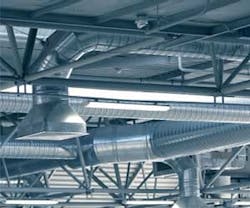Smart Sensor Options for HVAC
Roughly one-third of all commercial HVAC units are too big for the spaces they serve, says Jeff Riordan, director of business development for Irisys, a developer of thermal imaging and people-counting technology. This often results in excessive energy costs that seriously impact a building’s bottom line financial performance.
Higher-than-needed energy expenditures may be passed along as inflated tenant fees or increased costs for products and services, which make businesses less competitive – particularly when those dollars could be invested in research, development, new staff or revenue-growing initiatives.
Strategic energy optimization methods, however, can transition an oversized HVAC system into a more “right-sized” system that adjusts to dynamic occupancy levels that fluctuate during the day or week, Riordan says. These methods help lower operational costs which can be reallocated to other areas.
While building automation solutions already exist, the addition of a smart sensor can be a key component in making some of these solutions even smarter, Riordan says. Increasingly popular HVAC optimization strategies include:
Building Automation Systems
A building automation system (BAS) not only puts the building operator in greater control of the facility’s temperature and comfort, but also allows the operator to track inefficient energy expenditures.
Not just limited to monitoring and adjusting temperatures, a BAS also measures ambient light, occupancy levels, indoor air quality and humidity to fine-tune its program and control lighting circuits, comfort setpoints, fresh air and energy usage more effectively.
For example, if the BAS detects no one is occupying a certain zone, it may adjust accordingly, even if the standard program dictates otherwise. A BAS used throughout a particular building, over time, may actually learn occupant habits. It will then create a program to meet energy needs in the most efficient way possible.
Variable Speed Motors
A single-speed fan motor runs at one level: its highest. More than 95 percent of all HVAC systems in the United States use single-speed fan motors. Variable speed motors, however, give more flexibility in heating and cooling because, as the name implies, they run fans at varying speeds – not just the maximum speed.
Modest changes in airflow result in significant energy savings, according to the fan affinity law from physics. For example, when the speed of a fan motor is decreased 20 percent, the air flow also decreases 20 percent, but actual energy usage drops 50 percent. The resulting energy consumption is lower – as are the building’s energy expenditures.
Adding variable frequency drive units to existing single speed blower fans – and adjusting the speed of fans based on levels of occupancy – may make it possible to generate even better energy savings.
Demand Controlled Ventilation
Not all areas of a building are created equally. Some parts may flurry with activity at one time of the day and be virtually unoccupied during others – meaning money is being wasted when an HVAC uniformly heats or cools a building that doesn’t have uniform occupancy and usage.
That’s where demand controlled ventilation systems step in. Demand controlled ventilation (DCV) is a ventilation system feature that automatically drops outdoor air intake below the building’s original design rates, so energy usage decreases when space occupancy levels drop below design-based occupancy.
Traditionally, measuring space carbon dioxide has been the most common method of determining occupancy. Unfortunately, the delay in getting accurate counts when using carbon dioxide sensors may cause the control system to react too slowly to match true occupancy level needs. The preferred method of managing DCV is to use people counters that more accurately determine occupancy levels.
